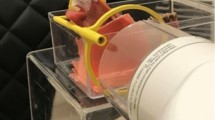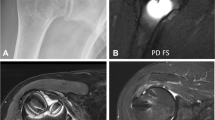Abstract
Several factors can cause bone loss and fixation failure following total hip arthroplasty (THA), including polyethylene wear debris, implant micromotion and stress shielding. Various techniques have been used in an effort to detect bone density loss in vivo, all with varying success. Quantitative computed tomography (qCT)-assisted osteodensitometry has been shown to be useful in assessing the in vivo structural bone changes after THA. It has a high resolution, accuracy and reproducibility, thereby making it a useful tool for research purposes, and it is able to differentiate between cortical and cancellous bone structures and assess the bone/implant interface. This technique also provides valuable information about the pattern of stress shielding which occurs around the prosthesis and can show early bony changes, which may prove informative about the quality of implant fixation and surrounding bone adaptation. In conjunction with finite-element analysis, qCT is able to generate accurate patient-specific meshes on which to model implants and their effect on bone remodelling. This technology can be useful to predict bone remodelling and the quality of implant fixation using prostheses with different design and/or biomaterials. In the future, this tool could be used for pre-clinical validation of new implants before their introduction in the market-place.
Résumé
Plusieurs facteurs peuvent causer une perte osseuse et la faillite de la fixation après une arthroplastie totale de la hanche. Ils incluent les débris de polyéthylène, la micromobilité des implants et le transfert de contraintes. Plusieurs techniques ont été utilisées pour détecter la perte de densité osseuse, avec des succés variés. L’ostéodensitométrie quantitative par scanner s’est montrée utile dans l’étude in vivo des modifications structurales osseuses après arthroplastie totale de la hanche. Elle a une haute résolution, une précision et une reproductibilité qui en font un outil approprié pour la recherche. L’ostéodensitométrie quantitative peut différencier l’os cortical et l’os spongieux, étudier l’interface os-implant et donner des informations sur le modèle de déviation des contraintes qui surviennent autour d’une prothèse. Elle peut montrer précocement des modifications osseuses, ce qui renseigne sur la qualité de la fixation des implants et l’adaptation de l’os voisin. En conjonction avec l’analyse par éléments finis elle peut générer un maillage précis spécifique du patient permettant l’étude de modèles d’implants et leur effet sur le remodelage osseux. Cette technologie peut être utile pour prévoir le remodelage osseux et la qualité de la fixation pour des prothèses de différentes formes et/ou matériaux. Dans le future cet outil pourra être utilisé pour la validation pré-clinique de nouveaux implants avant leur introduction sur le marché.






Similar content being viewed by others
References
Aamodt A, Kvistad KA, Andersen E (1999) Determination of the Hounsfield value for CT-based design of custom femoral stems. J Bone Joint Surg Br 81:143–147
Cohen B, Rushton N (1995) Accuracy of DEXA measurement on bone mineral density after total hip arthroplasty. J Bone Joint Surg Br 77:479–483
Engh CA Jr, McAuley J, Sychterz CJ, Sacco ME, Engh CA Sr (2000) The accuracy and reproducibility of radiographic assessment of stress-shielding. J Bone Joint Surg Am 82:1414–1420
Gibbons CE, Davies AJ, Amis AA, Olearnik H, Parker BC, Scott JE (2001) Periprosthetic bone mineral density changes with femoral components of differing design philosophy. Int Orthop 25:89–92
Kroger H, Venesmaa P, Jurvelin J, Miettinen H, Suomalainen O, Alhava E (1998) Bone density at the proximal femur after total hip arthroplasty. Clin Orthop Rel Res 352:66–74
Laine HJ, Puolakka TJ, Moilanen T, Pajamaki KJ, Wirta J, Lehto MU (2000) The effects of cementless femoral stem shape and proximal surface texture on ‘fit-and-fill’ characteristics and on bone remodeling. Int Orthop 24:184–190
Leali A, Fetto JF (2004) Preservation of femoral bone mass after total hip replacements with a lateral flare stem. Int Orthop 28:151–154
Lindgren JU, Svensson O, Mathieson EB (1996) Remodelling and pain after uncemented total hip replacement. Int Orthop 20:7–11
Martini F, Sell S, Kremling E, Kusswetter W (1996) Determination of periprosthetic bone density with the DEXA method after implantation of custom-made uncemented femoral stems. Int Orthop 20:218–221
Mirsky EC, Einhorn TA (1998) Bone densitometry in orthopaedic practice. J Bone Joint Surg Am 80:1687–1698
Mow VC, Flatow EL, Foster RJ (1994) Biomechanics. In: Simon SR (ed) Orthopaedic basic science. American Academy of Orthopaedic Surgeons, Rosemont, Ill.
Niinimaki T, Junila J, Jalovaara P (2001) A proximal fixed anatomic femoral stem reduces stress shielding. Int Orthop 25:85–88
Rosenbaum TG, Bloebaum RD, Ashrafi S, Lester K (2006) Ambulatory activities maintain cortical bone after total hip arthroplasty. Clin Orthop Rel Res (in press)
Rosenthall L, Bobyn JD, Tanzer M (1999) Bone densitometry: influence of prosthetic design and hydroxyapatite coating on regional adaptive bone remodelling. Int Orthop 23:325–329
Sanchez-Sotelo J, Lewallen DG, Harmsen WS, Harrington J, Cabanela ME (2004) Comparison of wear and osteolysis in hip replacement using two different coatings of the femoral stem. Int Orthop 28:206–210
Schmidt R, Muller L, Kress A, Hirschfelder H, Aplas A, Pitto RP (2002) A computed tomography assessment of femoral and acetabular bone changes after total hip arthroplasty. Int Orthop 26:299–302
Schmidt R, Mueller L, Nowak TE, Pitto RP (2003) Clinical outcome and periprosthetic bone remodelling of an uncemented femoral component with taper design. Int Orthop 27:204–207
Schmidt R, Nowak TE, Mueller L, Pitto RP (2004) Osteodensitometry after total hip replacement with uncemented taper-design stem. Int Orthop 28:74–77
Schmidt R, Pitto RP, Kress A et al (2005) Inter- and Intraobserver assessment of periacetabular osteodensitometry after cemented and uncemented total hip arthroplasty using computed tomography. Arch Ortho Trauma Surg 125:291–297
Shim V, Pitto RP, Streicher RM, Hunter PJ, Anderson IA (2006) The use of sparse CT datasets for auto-generating FE models of the femur and pelvis. J Biomech (in press; Epub: Jan 19)
Sumner DR, Galante JO (1992) Determinants of stress shielding: design versus materials versus interface. Clin Orthop Rel Res 274:202–212
Weber D, Pomeroy DL, Brown R, Schaper LA, Badenhausen WE Jr, Smith W, Curry JI, Suthers KE (2000) Proximally porous coated femoral stem in total hip replacement–5- to 13-year follow-up report. Int Orthop 24:97–100
Wilkinson JM, Peel NFA, Elson RA, Stockley I, Eastell R (2001) Measuring bone mineral density of the pelvis and proximal femur after total hip arthroplasty. J Bone Joint Surg Br 83:283–288
Wright JM, Pellicci PM, Salvati EA, Ghelman B, Roberts MM, Koh JL (2001) Bone density adjacent to press-fit acetabular components: a prospective analysis with quantitative computed tomography. J Bone Joint Surg Am 83:529–533
Zerahn B, Storgaard M, Johansen T, Olsen C, Lausten G, Kanstrup IL (1998) Changes in bone mineral density adjacent to two biomechanically different types of cementless femoral stems in total hip arthroplasty. Int Orthop 22:225–229
Zerahn B, Lausten GS, Kanstrup IL (2004) Prospective comparison of differences in bone mineral density adjacent to two biomechanically different types of cementless femoral stems. Int Orthop 28:146–150
Author information
Authors and Affiliations
Corresponding author
Rights and permissions
About this article
Cite this article
Pitto, R.P., Mueller, L.A., Reilly, K. et al. Quantitative computer-assisted osteodensitometry in total hip arthroplasty. International Orthopaedics (SICO 31, 431–438 (2007). https://doi.org/10.1007/s00264-006-0257-x
Received:
Accepted:
Published:
Issue Date:
DOI: https://doi.org/10.1007/s00264-006-0257-x




